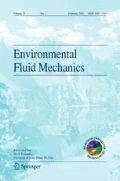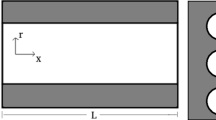Abstract
Water flow in porous media is strongly controlled by the microscale structure of the pore space. Therefore, understanding the dynamics at pore scale is fundamental to better estimate and describe the hydraulic properties and phenomena associated to water flow which are observed in a macroscale such as field or laboratory experiments. Pore geometry plays a key role since its variations cause modifications in hydraulic behaviour at the macroscale. In this study, we develop a new analytical model which represents the pore space of a medium as a bundle of tortuous sinusoidal capillary tubes with periodic pore throats and a fractal pore-size distribution. This model is compared with a previous model of straight constrictive capillary tubes in order to analyze the effect of pore geometry on hydraulic properties under partially saturated conditions. The comparison of the constitutive models shows that macroscopic hydraulic properties, porosity and permeability, present the strongest differences due to changes in the pore geometry. Nonetheless, no variations are observed in the relative hydraulic properties, effective saturation and relative permeability. The new model has been tested with experimental data consisting on sets of porosity-permeability, water content-pressure head, conductivity-pressure head, and hysteretic water content-pressure values. In all cases, the model is able to satisfactorily reproduce the data. This new analytical model presents an improvement over the previous model since the smoother variation of the pore radii allows a more realistic representation of the porous medium.
Article highlights
-
New constitutive model to describe hydraulic properties of porous media.
-
Variations in pore geometry significantly influence porosity and permeability estimates.
-
The physically-based model has analytical closed-form expressions whose predictions are consistent with laboratory data.








Similar content being viewed by others
Data availibility
Not applicable. No original data, everything has been published before.
Code availability
Not applicable.
Abbreviations
- REV:
-
Representative elementary volume
- R :
-
Radius of a circular tube (m)
- a :
-
Radial factor of the constrictivity
- c :
-
Length factor of the constrictivity
- \(\lambda\) :
-
Wavelength (m)
- l :
-
Pore length (m)
- r(x):
-
Pore radius variation along the longitudinal variable x (m)
- M :
-
Integer number
- \(V_p\) :
-
Pore volume (m\(^3\))
- \(f_v\) :
-
Reduction factor in a pore volume and in the porosity
- \(q_p\) :
-
Pore volumetric water flow (m\(^3\) s\(^{-1}\))
- \(\varDelta h\) :
-
Pressure head drop (m)
- \(f_k\) :
-
Reduction factor in a pore volumetric water flow and in the permeability
- \(R_{REV}\) :
-
REV radius (m)
- L :
-
REV length (m)
- \(\tau\) :
-
Tortuosity
- N(R):
-
Number of pores of radius equal or larger than R
- D :
-
Fractal dimension
- \(R_{min}\) :
-
Minimum pore radius (m)
- \(R_{max}\) :
-
Maximum pore radius (m)
- \(\phi\) :
-
Porosity
- q :
-
Volumetric water flow through the REV (m\(^3\) s\(^{-1}\))
- k :
-
Permeability (m\(^2\))
- \(k_{rel}\) :
-
Relative permeability
- h :
-
Pressure head (m)
- \(T_s\) :
-
Surface tension (N m\(^{-1}\))
- \(\beta\) :
-
Contact angle (degrees)
- \(S_e\) :
-
Effective saturation
- \(S_e^d\),\(S_e^w\) :
-
Main drying and wetting effective saturation, respectively
- \(h_{min}\) :
-
Minimum pressure head (m)
- \(h_{max}\) :
-
Maximum pressure head (m)
- \(k_{rel}^d\),\(k_{rel}^w\) :
-
Main drying and wetting relative permeability, respectively
- \(\rho\) :
-
Water density (kg m\(^{-3}\))
- g :
-
Gravity (m s\(^{-2}\))
- \(\mu\) :
-
Water dynamic viscosity (Pa s)
References
Bear J (1998) Dynamics of fluids in porous media. Dover Publications Inc, Mineola, N.Y
Blunt MJ, Jackson MD, Piri M, Valvatne PH (2002) Detailed physics, predictive capabilities and macroscopic consequences for pore-network models of multiphase flow. Adv Water Resour 25(8–12):1069–1089
Bodurtha P (2003) Novel techniques for investigating the permeation properties of environmentally-friendly paper coatings: the influence of structural anisotropy on fluid permeation in porous media. University of Plymouth
Bousfield DW, Karles G (2004) Penetration into three-dimensional complex porous structures. J Colloid Interface Sci 270(2):396–405
Brooks RH, Corey AT (1964) Hydraulic properties of porous media and their relation to drainage design. Trans ASAE 7(1):26–0028
Bryant S, Blunt M (1992) Prediction of relative permeability in simple porous media. Phys Rev A 46(4):2004
Buckingham E (1907) Studies on the movement of soil moisture. US Dept Agic Bur Soils Bull 38
Burdine NT (1953) Relative permeability calculations from pore size distribution data. J Petrol Technol 5(03):71–78
Cai J, Chen Y, Liu Y, Li S, Sun C (2022) Capillary imbibition and flow of wetting liquid in irregular capillaries: a 100-year review. Advances in Colloid and Interface Science p 102654
Carman PC (1937) Fluid flow through granular beds. Trans Inst Chem Eng 15:150–166
Chen K, Liang F, Wang C (2021) A fractal hydraulic model for water retention and hydraulic conductivity considering adsorption and capillarity. J Hydrol 602:126763
Darcy H (1856) Exposition et application des principes à suivre et des formules à employer dans les questions de distribution d’eau. Les fontaines publiques de la ville de Dijon, Eds Victor Dalmont, Paris 1856
Dong H, Blunt MJ (2009) Pore-network extraction from micro-computerized-tomography images. Phys Rev E 80(3):036307
Gao Z, Hu Q (2013) Estimating permeability using median pore-throat radius obtained from mercury intrusion porosimetry. J Geophys Eng 10(2):025014
Guarracino L, Rötting T, Carrera J (2014) A fractal model to describe the evolution of multiphase flow properties during mineral dissolution. Adv Water Resour 67:78–86
Joekar-Niasar V, Prodanović M, Wildenschild D, Hassanizadeh SM (2010) Network model investigation of interfacial area, capillary pressure and saturation relationships in granular porous media. Water Resources Research 46(6)
Jougnot D, Mendieta A, Leroy P, Maineult A (2019) Exploring the effect of the pore size distribution on the streaming potential generation in saturated porous media, insight from pore network simulations. J Geophys Res Solid Earth 124(6):5315–5335
Jury WA, Gardner WR, Gardner WH (1991) Soil physics. John Wiley & Sons, Inc, New York
Kozeny J (1927) Uber kapillare leitung der wasser in boden. Royal Acad Sci Vienna Proc Class I 136:271–306
Lindquist WB, Venkatarangan A, Dunsmuir J, Wong T (2000) Pore and throat size distributions measured from synchrotron X-ray tomographic images of Fontainebleau sandstones. J Geophys Res Solid Earth 105(B9):21509–21527
Man HN, Jing XD (1999) Network modelling of wettability and pore geometry effects on electrical resistivity and capillary pressure. J Petrol Sci Eng 24(2–4):255–267
Mesri G, Olson RE (1971) Mechanisms controlling the permeability of clays. Clays Clay Miner 19(3):151–158
Moebius F, Or D (2012) Interfacial jumps and pressure bursts during fluid displacement in interacting irregular capillaries. J Colloid Interface Sci 377(1):406–415
Mualem Y (1976) A catalog of the hydraulic properties of unsaturated soils. Research Project 442, Technion-Israel Inst Technol, Haifa p 100p
Mualem Y (1976) A new model for predicting the hydraulic conductivity of unsaturated porous media. Water Resour Res 12(3):513–522
Mualem Y (1986) Hydraulic conductivity of unsaturated soils: prediction and formulas. Methods of Soil Analysis: Part 1—Physical and Mineralogical Methods (Agronomy Monograph no.9 (2nd Edition)): 799–823
Oh S, Kim YK, Kim JW (2015) A modified van Genuchten-Mualem model of hydraulic conductivity in korean residual soils. Water 7(10):5487–5502
Or D, Tuller M (1999) Liquid retention and interfacial area in variably saturated porous media: upscaling from single-pore to sample-scale model. Water Resour Res 35(12):3591–3605
Petersen EE (1958) Diffusion in a pore of varying cross section. AIChE J 4(3):343–345
Pham HQ, Fredlund DG, Barbour SL (2005) A study of hysteresis models for soil-water characteristic curves. Canad Geotech J 42(6):1548–1568
Reis JC, Acock AM (1994) Permeability reduction models for the precipitation of inorganic solids in berea sandstone. In Situ 18(3):347–368
Rembert F, Jougnot D, Guarracino L (2020) A fractal model for the electrical conductivity of water-saturated porous media during mineral precipitation-dissolution processes. Adv Water Resour 145:103742
Soldi M, Guarracino L, Jougnot D (2017) A simple hysteretic constitutive model for unsaturated flow. Transp Porous Media 120(2):271–285
Spiteri EJ, Juanes R, Blunt MJ, Orr FM (2008) A new model of trapping and relative permeability hysteresis for all wettability characteristics. Spe J 13(03):277–288
Stanić F, Cui YJ, Delage P, De Laure E, Versini PA, Schertzer D, Tchiguirinskaia I (2020) A device for the simultaneous determination of the water retention properties and the hydraulic conductivity function of an unsaturated coarse material; application to a green-roof volcanic substrate. Geotech Test J 43(3)
Stanić F, Delage P, Tchiguirinskaia I, Versini PA, Cui YJ, Schertzer D (2020) A new fractal approach to account for capillary and adsorption phenomena in the water retention and transfer properties of unsaturated soils. Water Resour Res 56(12):e2020WR027808
Thanh LD, Jougnot D, Van Do P, Van Nghia AN (2019) A physically based model for the electrical conductivity of water-saturated porous media. Geophys J Int 219(2):866–876
Topp GC, Miller EE (1966) Hysteretic moisture characteristics and hydraulic conductivities for glass-bead media. Soil Sci Soc Am J 30(2):156–162
Tuller M, Or D, Dudley LM (1999) Adsorption and capillary condensation in porous media: liquid retention and interfacial configurations in angular pores. Water Resour Res 35(7):1949–1964
Tyler SW, Wheatcraft SW (1990) Fractal processes in soil water retention. Water Resour Res 26(5):1047–1054
Van Genuchten MT (1980) A closed-form equation for predicting the hydraulic conductivity of unsaturated soils. Soil Sci Soc Am J 44(5):892–898
Vogel HJ, Roth K (2001) Quantitative morphology and network representation of soil pore structure. Adv Water Resour 24(3–4):233–242
Wang S, Wu T, Qi H, Zheng Q, Zheng Q (2015) A permeability model for power-law fluids in fractal porous media composed of arbitrary cross-section capillaries. Phys A Stat Mech Appl 437:12–20. https://doi.org/10.1016/j.physa.2015.05.089
Xu C, Torres-Verdín C (2013) Pore system characterization and petrophysical rock classification using a bimodal gaussian density function. Math Geosci 45(6):753–771
Xu P, Zhang L, Rao B, Qiu S, Shen Y, Wang M (2020) A fractal scaling law between tortuosity and porosity in porous media. Fractals 28(02):2050025
Yang H, Rahardjo H, Leong EC, Fredlund DG (2004) Factors affecting drying and wetting soil-water characteristic curves of sandy soils. Canad Geotech J 41(5):908–920
Yu B (2008) Analysis of flow in fractal porous media. Appl Mech Rev 61(5):050801
Yu B, Li J (2001) Some fractal characters of porous media. Fractals 9(03):365–372
Yu B, Lee LJ, Cao H (2002) A fractal in-plane permeability model for fabrics. Polym Compos 23(2):201–221
Yu B, Li J, Li Z, Zou M (2003) Permeabilities of unsaturated fractal porous media. Int J Multiph Flow 29(10):1625–1642
Acknowledgements
The authors thank the Editor and two anonymous reviewers for their constructive comments and suggestions which helped to improve the original version of the manuscript. This research is partially supported by Universidad Nacional de La Plata, Consejo Nacional de Investigaciones Científicas y Técnicas (Argentina), Sorbonne Université and Centre National de la Recherche Scientifique (France).
Funding
None.
Author information
Authors and Affiliations
Contributions
Conceptualization: MS, LG, DJ; Methodology: MS, LG, DJ; Writing-original draft preparation: MS, LG, DJ; Writing-review and editing: MS, LG, DJ; Investigation: MS, LG, DJ; Supervision: LG, DJ.
Corresponding author
Ethics declarations
Conflict of interest
The authors declare that they have no conflict of interest.
Additional information
Publisher's Note
Springer Nature remains neutral with regard to jurisdictional claims in published maps and institutional affiliations.
Rights and permissions
Springer Nature or its licensor holds exclusive rights to this article under a publishing agreement with the author(s) or other rightsholder(s); author self-archiving of the accepted manuscript version of this article is solely governed by the terms of such publishing agreement and applicable law.
About this article
Cite this article
Soldi, M., Guarracino, L. & Jougnot, D. The effect of pore geometry in constitutive hysteretic models for unsaturated water flow. Environ Fluid Mech 22, 1283–1305 (2022). https://doi.org/10.1007/s10652-022-09891-0
Received:
Accepted:
Published:
Issue Date:
DOI: https://doi.org/10.1007/s10652-022-09891-0




